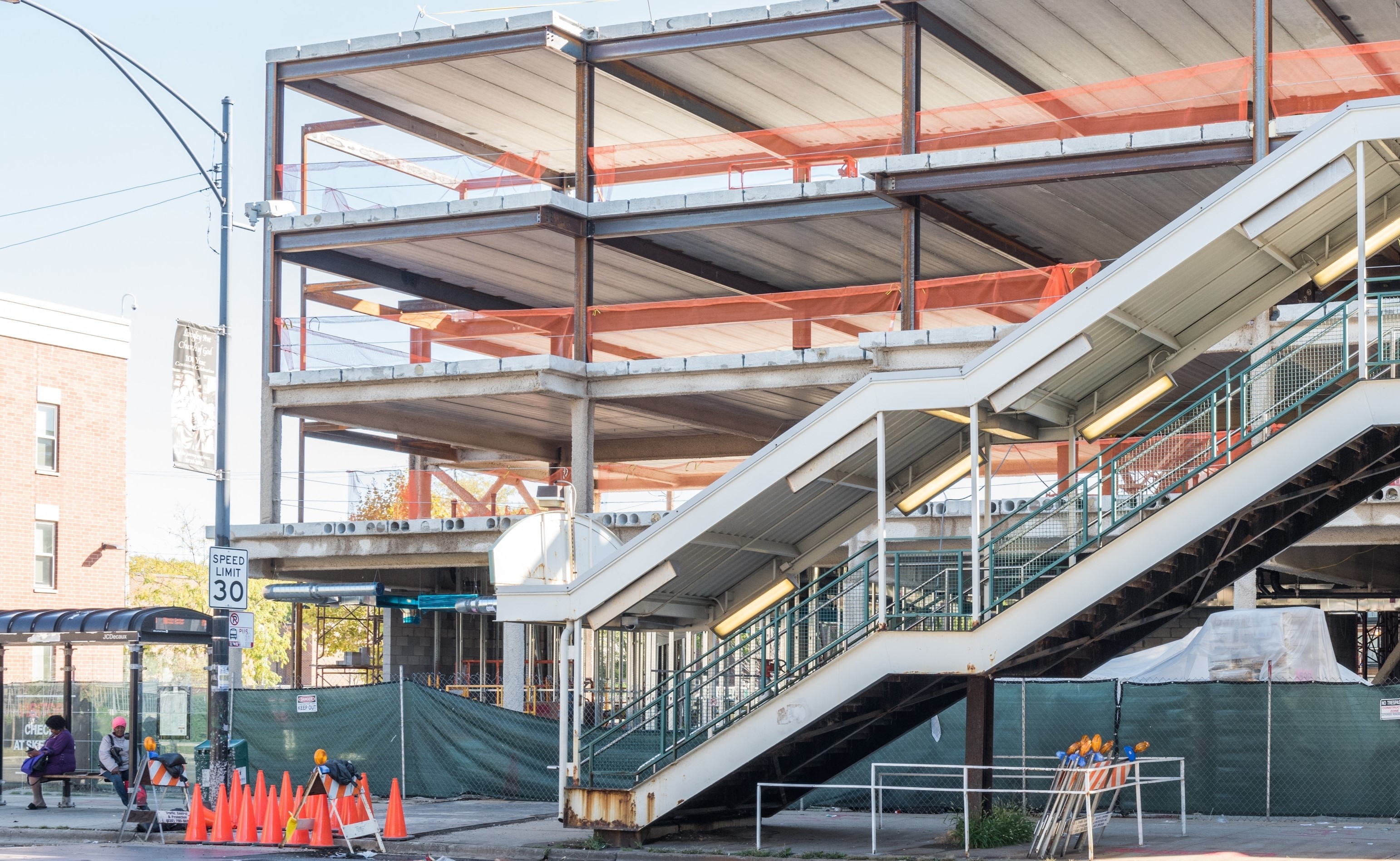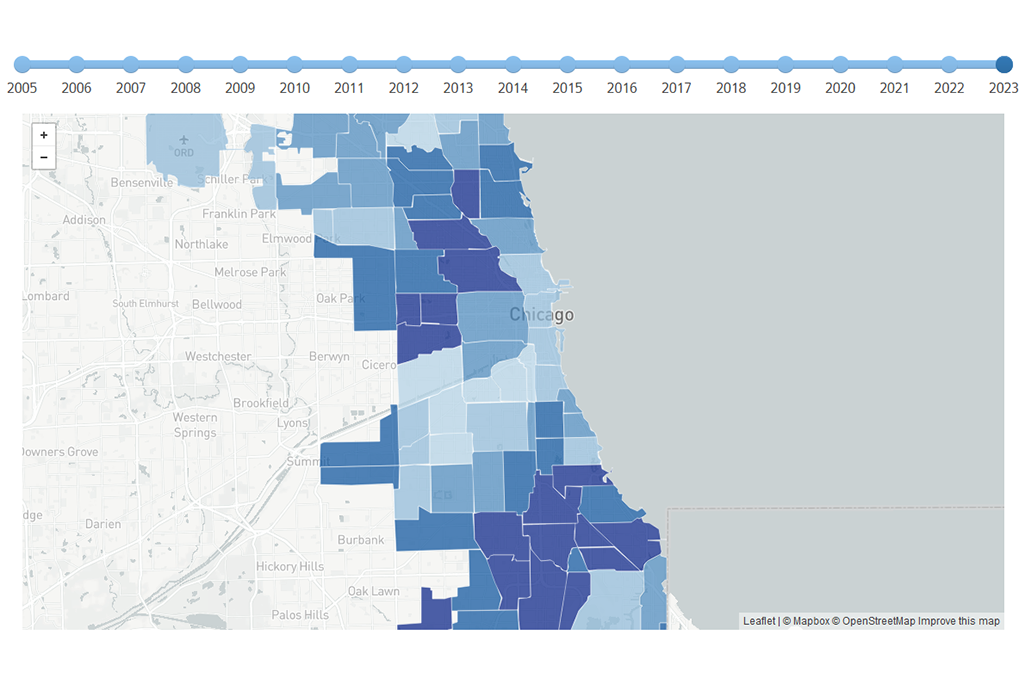Every week there are new stories in the Chicago media highlighting neighborhood real estate investments, announcing new development projects, or describing the ways neighborhood residents are responding to housing market and demographic changes in their communities.
To help track these stories and put them in a market context, IHS developed a new tool that maps the locations featured in these stories alongside our neighborhood displacement pressure market typologies. Viewing these stories together with our displacement risk indicators can provide spatial, housing market, and demographic context and help readers assess the potential implications of the activities described in each article.
Explore the map tool below by clicking on each point to display the related media story and access the link to the original story. Users can click each census tract to display housing market typology information. The mapping tool will be updated regularly as new media stories appear and as we update the underlying data. Click here for a full page version of the map below.
Note: To view certain media stories, you'll be required to open them in a new tab or window.
LOCAL STORIES AND CHANGING HOUSING MARKET DYNAMICS
As market dynamics change and new investment occurs across Chicago’s various community areas, the loss of affordable rental housing can lead to increased housing instability and can cause residents to feel a growing risk of displacement. Both national and citywide reports have examined trends of unresolved gaps in the stock of affordable housing and local media stories highlight the on-the-ground experience of these changing housing market elements and heightened pressures.
Market changes occur across various parts of the city, all of which have their own, unique dynamics and subsequent challenges. In some areas, neighborhoods have experienced years of disinvestment, causing population decline, a deteriorating housing stock, and challenges to quality of life, and affordable units are not necessarily replaced as quickly as they are lost.
In other Chicago neighborhoods, residents are experiencing affordability pressures as rental demand soars and development activity spikes. Planned projects have the potential to shift market dynamics in surrounding areas as rental demand, and therefore prices, rise.
UNDERSTANDING RISK LEVELS
Created in 2017, IHS’s Mapping Displacement Pressure Tool uses market indicators to detect areas in Chicago where vulnerable populations may be experiencing affordability pressures and displacement risk due to increased housing costs. Since the project’s creation, the tool has been a relevant means of understanding increasing unaffordability in areas where new investments and development activities are taking place. Both the original tool and Mapping Neighborhood Change mapping tool feature displacement risk indicators that categorize neighborhood areas into three displacement risk levels:
- High-cost areas in the City where displacement is likely well underway
- Moderate-cost communities where displacement risk could be accelerated with certain projects or initiatives, especially if near transit, other existing amenities, or high-cost real estate markets
- Lower-cost areas that have seen recent market movement but still require significant investment and long-term strategies to rebuild housing demand before displacement due to rising costs becomes an issue
Each market type has different drivers of demand, different current conditions, and therefore different risks associated with displacement.
For high-cost areas, displacement pressure is likely coming from higher-income households and investors targeting these households, while pressure in more affordable areas is likely due to investors seeking value in potentially rising markets. For lower-cost areas, rising prices may indicate a stabilizing market or property speculation, but long-term disinvestment is likely still a central concern and driver of neighborhood change rather than gentrification.
RESPONDING TO DISPLACEMENT PRESSURE
Media stories highlight the variation of activity and the spectrum of effects resulting from activity such as large-scale investment, prices of new developments, and speculative investment, among others. In many areas, tenants are currently feeling the effects of housing affordability pressures. Many have taken measures to protect their homes from becoming unaffordable and rejecting developments that do not provide affordable units or that they feel might push their areas to a point of displacement.
Several articles have also followed the implementation of strategies by housing advocates and mission-driven developers to protect affordable housing and generate new, affordable housing options in neighborhoods that are experiencing spikes in investment.
Small business owners often join local residents in feeling the pressures of increased property values in different community areas. Several media stories follow the closure of long-standing local shops and restaurants that can no longer afford to remain open or have consistently lost clientele as the surrounding neighborhood demographics change. Some business owners are able to relocate to a more affordable area of the city, but other owners end up closing their shops for good.
METHOD
The media articles above have been mapped by our new tool because they satisfy the following criteria:
- Article involves a location at a specific address or at a location that is able to be mapped.
- Subject matter relates to affordable housing creation and preservation efforts, residential property sales or investments, small business displacement, neighborhood change, development of luxury or high-cost housing, major development projects or proposals, or tenant advocacy against gentrification and displacement.
- Subject matter occurs within or adjacent to areas IHS’s displacement risk map has identified as low-risk, moderate-risk, or high-risk areas.






